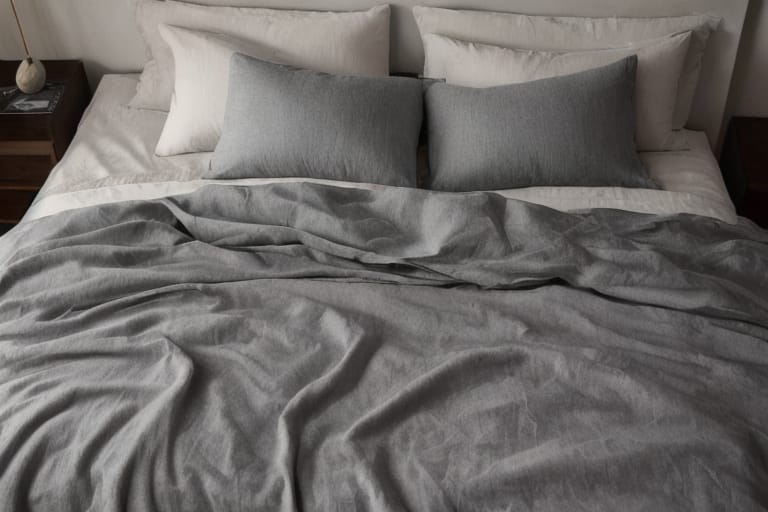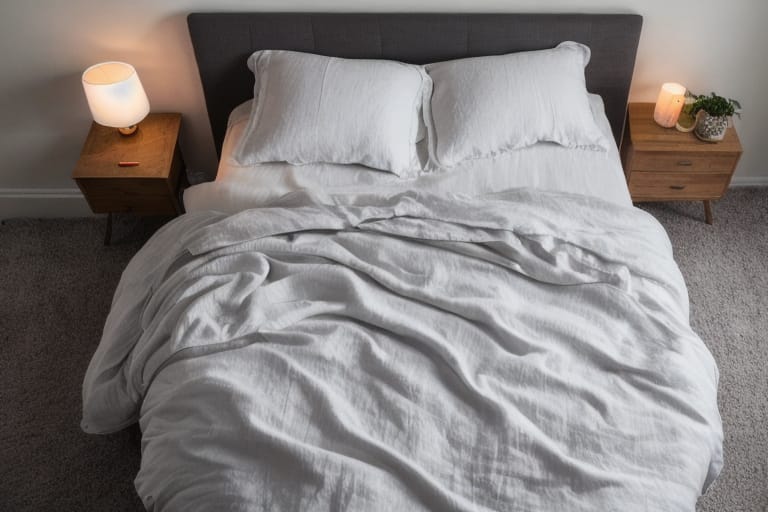Are you a hot sleeper who struggles with night sweats? Overheating at night can disrupt your sleep and leave you feeling unrested. The right bedding is key to staying cool and comfortable all night long. But does down bedding like comforters and duvets make night sweats worse? Let’s find out.
Night sweats are no joke—waking up drenched in sweat is downright unpleasant. As a fellow hot sleeper, I know the struggle. I used to toss and turn all night, kicking off blankets only to wake up shivering a few hours later. It was a vicious cycle that left me exhausted.
After lots of trial and error, I finally found bedding that keeps me blissfully cool and dry even on hot summer nights. The secret? Breathable fabrics that whisk away moisture and regulate body temperature.
In this beginner’s guide, you’ll get the complete lowdown on picking bedding to beat night sweats and overheating issues. I’ll cover everything from thread count to fill power so you can build your ideal sleep sanctuary.
What Causes Excessive Night Sweating?
Before we dive into bedding solutions, let’s quickly touch on what leads to night sweats in the first place. Common culprits include:
- Medical conditions like menopause, infections, cancer, and autoimmune diseases
- Hormone changes during menstruation, pregnancy, and andropause
- Environmental factors like a hot room, thick bedding trapping body heat, medications, spicy foods, alcohol, and stress
Pay attention to what makes you heat up. This can clue you into the best bedding approaches for your personal needs. Even small tweaks like cooling your bedroom or reducing evening caffeine can help night sweats.
Do Down Comforters and Duvets Cause Sweating?
Fluffy down-filled bedding conjures up images of snuggling under a fluffy cloud. But does the unbeatable softness come at the cost of sweaty sleep?
The Pros and Cons of Down Bedding
Down bedding offers exceptional comfort thanks to its:
- Light, airy feel from fattened duck or goose clusters that trap body heat.
- Luxurious softness from the fluffiness and compression of down.
- Durability to retain loft and maintain shape for years.
- Good breathability from the airy fill that allows airflow.
But for night sweat sufferers, down does have some drawbacks:
- Tendency to trap heat next to the body leading to overheating.
- Moisture retention rather than quick drying.
- Difficulty cleaning and drying compared to synthetic options.
- Higher cost than most bedding alternatives.
- Allergy triggering for those sensitive to dust and down proteins.
Clearly down comforters aren’t ideal for all hot sleepers. Next let’s explore alternatives that offer superior cooling power.
Bedding Filling Options for Hot Sleepers
Down bedding may not be the best choice if you struggle with truly excessive sweating at night. Luckily more breathable alternatives exist!
Synthetic Duvet Fillings
For cooling relief, synthetic fills made from microfibers offer exceptional advantages:
⭐Moisture-wicking to pull sweat off your body so you stay drier.
⭐Fast drying with quick evaporation so damp bedding recovers swiftly.
⭐Allergy-friendly materials less likely to trigger reactions.
⭐Easy care for hassle-free washing and drying at home.
⭐Affordability makes refreshing bedding practical as needs change.
Popular synthetic fills include:
- PrimaLoft® – This down alternative mirrors the feel of goose down using ultra-fine fibers. It offers great insulation without weight.
- microdenier polyester – Lightweight, breathable microfibers that resist clumping and dry quickly.
- TencelTM Lyocell – Made from eucalyptus cellulose, Tencel has a silky softness. Its moisture-wicking properties help heat dissipate.
Pro Tip: For severe night sweats, I recommend pure Tencel or bamboo comforters for unmatched cooling power.

Finding the Best Cooling Comforters and Duvet Inserts
Now that you know what to look for in fill material, let’s compare some popular cooling comforter options. I’ll also give suggestions on temperature regulating duvet inserts alternative down options.
Cooling Comforters
My top picks for breathable comforters that reduce sweating are:
★ Luxome Coolmax® Comforter
- Fill: Coolmax® polyester + hollow siliconized fibers
- Features: Advanced moisture management, 3D clusters maintain fill distribution
- Price: $$$
- **Best for:**keeping extremely hot sleepers dry all night
★ Buffy Cloud Comforter
- Fill: Proprietary BreezeTM polyester fill made from recycled bottles
- Features: Helps regulate temperature, soft and fluffy
- Price: $$
- Best for: eco-friendly style on a budget
★ Easeland Hypoallergenic Comforter
- Fill: 100% mulberry silk insert + cotton shell
- Features: Silk helps absorb sweat, cotton backing increases airflow
- Price: $$$$
- Best for: luxury plus cooling
Breathable Duvet Inserts
For added versatility to switch out covers, try these sweat-wicking duvet inserts:
★ Linenspa Reversible Down Alternative Insert
- Fill: 100% microfiber with 8 anchor loops to prevent shifting
- Features: Corner loops to tie to duvet, box stitch design
- Price: $
- Best for: budget-friendly basics
★ ROHOMO Duvet Insert
- Fill: Siberian goose down alternative + breathable cotton shell
- Features: Ultra-thin quilted channels support fill distribution
- Price: $$
- Best for: plush feel without overheating
Best Fabrics for Cooling Sheets and Duvet Covers
Cranking the AC isn’t a long-term solution for hot sleep struggles. That’s why bedding materials play such a key role.
Let’s compare the most breathable fabrics to keep you comfy all night long:
Cotton offers supreme breathability and helps absorb sweat. Choose high-quality long staple cotton woven into fine 200+ thread count sheets.
Linen is another top choice thanks to extreme moisture-wicking abilities. The natural fibers have hollow cores to allow exceptional airflow.
Lyocell fabrics like Tencel® excel at drawing moisture away from your skin. Plus they’re incredibly soft and smooth.
Bamboo manages humidity and dries rapidly to keep your bed fresh. Added ventilation from weave styles like jacquard boost cooling power.
I recommend pairing moisture-wicking sheets and duvet covers with your sweat-fighting comforter or insert. This creates a fully cooling sleep system for year-round comfort.
What’s the Deal with Tog Ratings for Bedding?
If you’re confused when shopping for bedding and come across phrases like “9 tog rating”—you’re not alone! Tog ratings indicate the insulation value of blankets and duvets. This measurement allows easier comparisons across bedding brands.
Here’s how togs translate:
- 1 to 4 togs – Ideal for hot sleepers since this bedding is quite breathable
- 7 to 10 togs – Warmer bedding better for cold environments or winter
- 10+ togs – Extra insulation reserved for frigid climates and outdoor use
Generally, higher tog ratings trap MORE body heat while lower numbers allow heat to dissipate. So shop for low tog bedding (1-4 togs) if night sweats are an issue.
Caring for Bedding to Extend Lifespan
Caring properly for bedding ensures your investment lasts. Follow these tips:
- Wash regularly – Every 1-2 weeks for sheets/covers, 1-2 times a year for comforters
- Read care labels – Look for machine washable bedding if convenience is key
- Air dry when possible – Line drying preserves fibers longer than high heat
- Use mild detergent – Harsh chemicals damage fabrics over time
- Handle with care – Fold or roll bedding rather than balling up to avoid tangles
With gentle care, high-quality sweat-wicking bedding should last around 5+ years even after hundreds of cycles through the washing machine.

Frequently Asked Questions
Still sweating the small stuff about picking bedding? Here are answers to some commonly asked questions:
What thread count is best for hot sleepers?
For the most breathability, look for sheets between 200-400 thread count. Over 400 TC, the weave becomes too dense for adequate airflow.
Is Egyptian cotton good for night sweats?
Yes! The extra long fibers of Egyptian cotton make fine, breathable fabric. Splurge for 600-800 TC sateen weave sheets for silken softness that gently wicks moisture.
What about down alternative comforters?
Down alternatives often contain polyester or other synthetic fills. These mimic the billowy feel of down while being more cooling and allergy-friendly.
Should you get 100% cotton comforters for night sweats?
It depends. 100% cotton comforters excel at absorption but dry slower than moisture-wicking synthetics. Pair cotton covers with quick-drying inserts for best results.
What’s the difference between a duvet and comforter?
Comforters have attached fabric shells while duvets feature removable covers. Inserts and shells allow further customization for optimal cooling, convenience and style.








